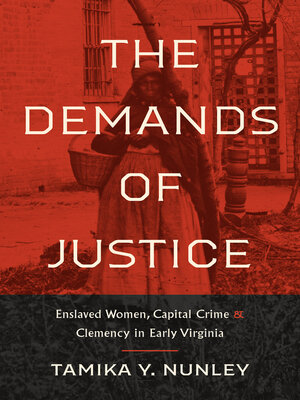The Demands of Justice
ebook ∣ Enslaved Women, Capital Crime, and Clemency in Early Virginia
By Tamika Y. Nunley

Sign up to save your library
With an OverDrive account, you can save your favorite libraries for at-a-glance information about availability. Find out more about OverDrive accounts.
Find this title in Libby, the library reading app by OverDrive.



Search for a digital library with this title
Title found at these libraries:
| Library Name | Distance |
|---|---|
| Loading... |
Award-winning historian Tamika Y. Nunley has unearthed the stories of enslaved Black women charged by their owners with poisoning, theft, murder, infanticide, and arson. While free Black and white people accused of capital crimes received a hearing, trial, and, if convicted, an opportunity to appeal, none of these options were available to enslaved people. Conviction was final, and only the state or owners could spare their accused chattel of punishment by death. For enslaved women in Virginia, clemency was not uncommon, but Nunley shows why this act ultimately benefitted owners and punished the accused with sale outside of the state as the best possible outcome.
Demonstrating how crimes, convictions, and clemency functioned within a slave society that upheld the property interests of white Virginians, Nunley reveals the frequency with which owners preferred to keep the accused in bondage, which allowed them, behind the veil of paternalism, to continue to benefit from Black women’s labor. This so-called clemency also sought to rob Black women of the power they exercised when they committed capital crimes. The testimonies that Nunley has collected and analyzed offer compelling glimpses of the self-identities forged by Black women as they attempted to resist enslavement and the limits of justice available to them in the antebellum courtroom.
Demonstrating how crimes, convictions, and clemency functioned within a slave society that upheld the property interests of white Virginians, Nunley reveals the frequency with which owners preferred to keep the accused in bondage, which allowed them, behind the veil of paternalism, to continue to benefit from Black women’s labor. This so-called clemency also sought to rob Black women of the power they exercised when they committed capital crimes. The testimonies that Nunley has collected and analyzed offer compelling glimpses of the self-identities forged by Black women as they attempted to resist enslavement and the limits of justice available to them in the antebellum courtroom.







